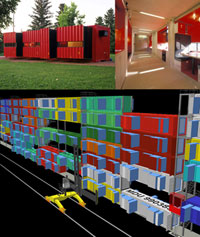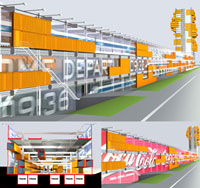by: Daniel Fox
Event: People and Buildings: Thinking Inside the Box
Location: Housing Works Bookstore Café, 01.30.07
Speakers: Giuseppe Lignano & Ada Tolla — Principals, LOT-EK; Marc Levinson, author, The Box: How the Shipping Container Made the World Smaller and the World Economy Bigger
Organizers: The Center for Urban Pedagogy (CUP); New York Council for the Humanities

Mobile Dwelling Units (MDU) travel as standard-size containers, expand to reveal furnished interiors, and could be plugged into “vertical harbors” in any city.
Courtesy LOT-EK
Home, gallery, train station, vertical village, museum, portable retail hut, mega-billboard, recycling plant: these are among the novel alternative uses that Giuseppe Lignano and Ada Tolla, founding principals of LOT-EK, have conceived for the thousands of surplus 20- and 40-foot-long standard shipping containers that accumulate like empty shoeboxes in U.S. port cities. Interpreting the containers as adaptable architectural shells rather than inherently defined freight boxes, the partners envision a radically modular landscape as liquid as capital itself.
Their January 30th presentation — part of CUP’s People and Buildings event series — complemented a lecture delivered by the economist Marc Levinson recounting the evolution of the modern shipping container. According to Levinson, a former editor of The Economist and author of a new book on shipping container history, the adoption of standard shipping containers in the 1950s-70s fueled the industrial decline of formerly bustling ports such as Brooklyn. LOT-EK’s designs creatively invert this relationship; in its hands the very same shipping containers become post-industrial building blocks to revitalize the city. The firm is on a mission to discover how many different types of program can be dynamically planted in, around, and between the containers.
One case study is the Mobile Dwelling Unit (MDU), which not only functions as an independent, fully furnished home, but hypothetically plugs in to a vast “vertical harbor,” or high-rise steel rack, in any metropolis. Said Lignano, “Like pixels in a digital image, temporary patterns are generated by the presence or absence of MDUs in different locations along the rack, reflecting the ever-changing composition of these colonies scattered around the globe.” The completed Bohen Foundation gallery and offices on West 13th St. shows how shipping containers can be adapted to create flexible interior volumes. Accommodating an entirely different program, the train station and tower they have proposed for Turin, Italy, is a 1,800-foot-long “programmable billboard” animated by the constant movement of trains, cars, passengers, and shoppers, as well as a giant stream of travel information and advertisements.
Recycling is one of LOT-EK’s goals, but not only in the material sense. Responding to Levinson’s account of endless negotiations over the exact specifications of standard containers, Lignano said he and Tolla would like to “recycle the intelligence and all the effort” spent developing the 8.5-foot-tall, 8-foot-wide steel and aluminum boxes. They also see latent pop-art value in the multi-colored containers. Shipping containers could one day become as ubiquitous in the built environment as they are on the seas and highways.
Gideon Fink Shapiro is a writer and researcher at Gabellini Sheppard Associates, and contributes to several design publications.









